I thumbed through the wine-stained menu at a popular taverna in Aghios Nikolais on the eastern edge of Crete. Meat, lamb and meat it said in four languages; in a succession of loud tourist restaurants it had been the same now every night for a week. Here, jammed up against the wall of the kitchen, we watched an intrepid lizard catching bugs in the wan electric light and tried to ignore the raucous guffaws coming from Germans crowding a nearby table.
There was something that worried me about the Salad Queen that night. She wasn’t quite her normal sparkly self. Her laugh sounded hollow when I pointed out the peculiar words that described Braised Lamb with Onions. She seemed a little tired when she ordered her usual horiatiki salad and a side of rice. At first, I thought it was a reaction to all the boisterous tourists around us. But then it hit me: she was barely getting enough to eat!
The next day, while looking for yet another pair of sunglasses (I swear Aegean translates as ‘sunglass-eating sea’), I asked around. The Aussie behind the counter at one open-fronted shop near the seawall told us of a place that might work. ‘I don’t know for sure,’ she shouted over the blasted sounds of Ace of Base, ‘but I hear they do veg if you ask nicely.’
In Chania on the north shore, the taverna with the raised patio was perfect. It was a little pricy by Greek standards, but less crowded than the cheaper tavernas down the street, and it featured quiet tables hidden by latticed arbors. The sweet honey smell of night-blooming jasmine hung in the air. We fell under the Greek spell as some of the spark returned to the Salad Queen’s eye.
The waiter, who knew some English, gave us the lowdown as he swept away jasmine flowers. ‘We Greeks eat many vegetable dishes at home,’ he said. ‘But when we go out, it’s different. We want meat. We want something Big.’ He scratched his head and took our menus. ‘I know what to do,’ he said conspiratorially as he bustled away.
He was beaming from ear to ear when he returned carrying large white plates brimming with dolmas, hummus, bread, fresh tomatoes, olives and roasted potatoes. And nestled amongst all that were small casserole dishes full to bursting with the biggest beans I’d ever seen.
‘Fasolia gigantes plaki,’ he announced proudly, and held himself up to full stature. ‘Giant Greek beans!’
I saw the light blaze again in my wife’s eyes as we devoured those delightful beans and later, as we breathed the night air deeply and strolled contentedly back toward our hotel, I saw her smiling to herself.
‘You know how the waiter came out again while you were paying?’ she asked, pausing to look at the boats bobbing in the little harbor. ‘He told me….’ She could hardly contain her mirth. ‘He told me those lovely beans were for the kitchen staff. They’re for the Greeks, not the tourists!’
My eyes got wide, and we fell together laughing. Some old men in fishermen’s caps eyed us darkly and a few carousing tourists moved stiffly aside to let us past. Arm in arm and back in the groove we strolled off into the night.
.
Fasolia Gigantes Plaki (Φασόλια Γίγαυτες Πλάκι)
500 grams Fasolia Gigantes, available at some Greek restaurants and specialty stores such as Pacific Food Importers here in Seattle
Water for soaking and simmering beans
1 large sweet onion, coarsely chopped
2 large carrots, coarsely chopped
3 large cloves garlic, minced
1½ teaspoons Greek oregano
1½ teaspoons thyme
2 ounces of Greek olive oil, divided
1-28 ounce can plum tomatoes
1½ teaspoons salt
½ teaspoon black pepper
2 teaspoons sugar
Crumbled feta and flatleaf parsley for garnish
Note: There is no absolute cooking time for these beans, so your teeth will have to tell you when they are cooked through without becoming mushy. Once they have attained the right texture, they will hold that throughout baking in the red sauce.
If you follow directions below and bring presoaked gigantes to a soft boil in about 15 minutes, the shortest cooking time from that point will be 50 minutes. After that, you’ll want to bite-test a bean every ten minutes; when the bean’s flesh gives all the way down with no hard bit in the middle, your beans are cooked to perfection.
Soak the gigantes: Soak beans overnight in cold water to cover by an inch or more. Minimum soaking time: 8 hours.
For baking in a woodfired oven: Start the fire if your oven is cold. For best results, your fire should be at least 1½ hours old when you put in the Gigantes.
Cook the gigantes: Drain the soaking water and replace with cold water to cover by an inch or more. Over medium heat, with a lid half cocked over the pan, bring the water slowly to a boil. This should take 15 minutes.
Boil gently with the lid partly covering for 50 minutes, at which point you want to test the beans every 10 minutes for doneness. Most beans I have cooked are done in about 1 hour and 10 minutes, but I have encountered a few batches of beans that, for one reason or another, take more than 1½ hours to reach tenderness. Beans are cooked when you can bite through a bean without encountering resistance in the middle.
Once beans are tender, strain off the water, sprinkle with olive oil and salt, and set aside.
Make the sauce: While the beans are cooking, simmer the onion, carrot and garlic in 1 ounce of olive oil over medium heat in a large frying pan or skillet. Sprinkle with some of the oregano and thyme.
After 10 minutes, when the onions are translucent and slightly brown at the edges, add the juice from the tomatoes. Chop the tomatoes (I do this with kitchen scissors in the can) and add to the veggies. Add the sugar, the salt and pepper and let simmer for at least 30 minutes, stirring as necessary to keep from sticking. Add ½ cup water and continue at a bare simmer until ready for the next step.
For baking in a conventional oven: Preheat oven to 400°
Assemble the casserole: Coat the bottom of a 9” x 12” lasagna pan or similar casserole dish with 2 teaspoons of olive oil. Spread first the gigantes and then the sauce as evenly as you can. Drizzle on any remaining olive oil and sprinkle with the remaining herbs.
For baking in a woodfired oven: Make sure you have a good bed of coals and two or three wrist-thick sticks of hardwood that have burned for 20 minutes still flaming moderately. Push the fire against the wall either at the back or the side of your oven, and sweep the ashes.
Put the uncovered casserole 12 inches from the fire and leave the door open just 1” to keep the flame down. Turn casserole after 20 minutes.
The beans will be ready when most of the liquid from the sauce has cooked away or been absorbed, 40 minutes to an hour depending on the heat of your oven.
For baking in a conventional oven: Put the casserole on the center rack of your oven. Turn the temperature down to 375°. Bake for 50 minutes or until most of the liquid has cooked away or been absorbed.
Serve gigantes hot, garnished with crumbled feta cheese and flatleaf parsley. These beans are awesome cold as well, served on the patio with pita bread and olives. Enjoy!

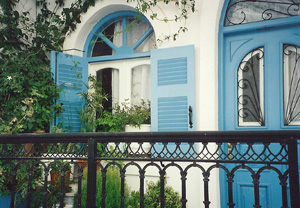
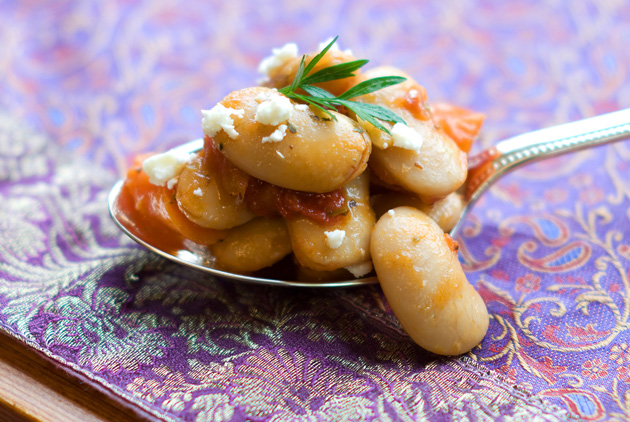
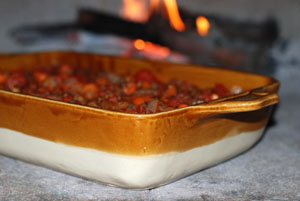
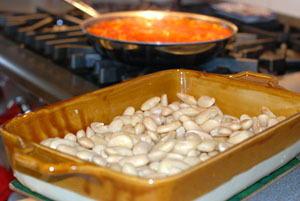
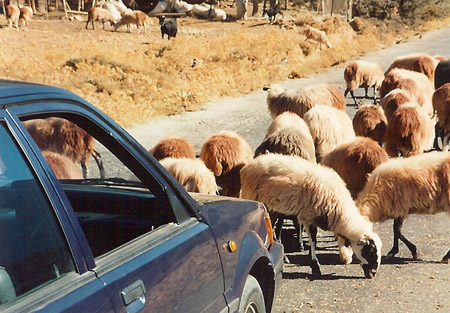
I just love those huge beans! I’ve gotta see if I can find some of them here in CA. Love the story too, wish I could’ve been there. The sheep picture is so cute!
We had these beans too when we were in Crete – so yummy!
I love this dish, I made it 2 days ago!
Mine was without the crumbled feta. next time i will definitely add it 🙂
This is a perfect ‘mezes’ something like snack with our traditinal Ouzo!
Cheers!
Oh how lovely. I do believe the next trip you embark upon, I will sneak into your suitcase!
Don,
That is one tastly looking spoonful of beans! I bet the wood fired oven gives them a whole other flavor also.
Bon appetit!
CCR
=:~)
Love me a big bean 🙂
Great story. Beans are delightful anytime on my menu, it just so darn hot to turn on the oven at times.
I will remember this if I’m ever fortunate enough to visit Greece! I love gigante beans, and this recipe sounds fantastic.
Lovely story. I like that you tease with the beans and then tell where to get them, just as I was wondering that very thing.
This has got to be the ultimate comfort food! I’m definitely saving this for when the weather gets cooler (right now LA is experiencing a heat wave and it’s nearly October ><). I just hope I can wait that long cause your macro shot of a spoonful of the cooked beans look absolutely mouthwatering… yum!
Hello, I was just wandering if you had a Facebook Page!
Thank you!
Gigantes plaki is a dish I have in my menu for year now. Very Good posting!!!
I’ve made these 3 times now {minus the woodfire oven unfortunately}. They are wonderful! I just posted about them on my blog, referring back to you here. Thank you so much for this recipe!
Way to go! What a fun website…! We haven’t tried any of the dishes, but I am anxious to compare your Fuji pie to my mom’s homemade pie from our orchard (I have no clue what apple variety we had.) Maybe it was the lard in her crust that made any apple taste good.
I will visit again.
Great way to integrate culture, food and fun.
What a delicious post – both in the recounting of your travels in Greece and in the final product!
Thank you!
love this recipe 🙂 When I was in greece fasolia was the main staple of my vegetarian diet… that and of course the moussaka which everyone promised had no meat in it– only lamb!
thank you for posting this recipe and bringing back sweet memories 🙂
This is one of my favorite Greek recipes. I usually add a ham bone in the mix for some extra flavor. It is the best winter dish period! Note: Make sure you soak the beans, and rinse the water frequently and thoroughly.
Just got through eating my first plate of these delicious beans. I love beans of any kind. These were cooked at Taverna To Paramithi in Kalambaka, Greece. Yummy! Hope I can find them at home.
I LOVE this recipe! Am able to buy and substiture huge fava beans and and find this combination to be as satisfying as any meal with meat that I’ve had. I consider this a comfort food type dish, and double the recipe so I can freeze up some portions. Thanks so much for sharing!
We spent a month in Greece this summer, and enjoyed beans in many different ways, all delicious, but this remains my favorite.
SO LOVE THIS RECIPE! Have been using huge fava beans which I now purchase from nuts.com, as they are no longer available in this area. I add spinach and increase carrots, but have otherwise left the recipe untouched. Make HUGE batches, as it freezes up very well. Keep these recipes coming!